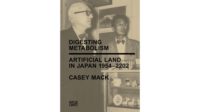Rem Koolhaas’s most recent publication (with Hans Ulrich Obrist) tells the story of Metabolism, a technocratic movement of the 1960s based on ideas of organic growth. Nine surprisingly personal interviews with Metabolist architects and related figures (such as Atushi Shimokobe, a government official who helped many of the architects get early commissions) make the book a page-turner. Chapters on 20th-century Japan are also engaging, as are the comments in side notes. Captioned photo essays supplement illustrations that are interspersed with the text.

Two key events in this meticulously researched history are the World Design Conference in 1960, which marked the beginning of the movement, and Expo ’70 in Osaka, its climax. However, just as the narrative goes beyond architecture to cover the politics, sociology, and culture of Japan, it follows those involved with Metabolism from the early 1970s to the present. Despite the distance he maintained from Metabolism, Kenzo Tange, the late dean of Japanese architecture, served as an eminence grise, a role that is vividly recalled by his right-hand man Arata Isozaki. Tange’s teaching and practice created a hospitable environment for new ideas, and he masterminded Expo ’70, which marked the restoration of Japan’s postwar moral and economic influence.
What makes the interviews so fascinating is the remarkable candor of the colorful interviewees. For example, the industrial designer Kenji Ekuan provides a hierarchical classification of the seven principal Metabolists; although the group included Fumihiko Maki and Kisho Kurokawa, the star seems to have been Kiyonori Kikutake. A recurring note of revival is sounded in Ekuan’s unexpected reaction to the hellish atomic ruins of Hiroshima, which he describes as “transformed ... by the setting sun into a dazzling vision of paradise.” Repeatedly, the war’s desolation is viewed as the potential for a new beginning, rather than the end of a civilization.
Some of the Metabolists experimented with plug-in architecture (which also fascinated the Archigram group in Great Britain at the time). Perhaps the most famous example of such work is Kurokawa’s 1972 Capsule Tower in Tokyo, which has survived but is now threatened with demolition. The Metabolists’ ongoing influence can be seen in the work of young firms such as Atelier Bow-Wow, which has explored the notion of “in-between” space in projects like the nomadic BMW Guggenheim Lab; such work recalls Metabolism’s search for alternatives to Japan’s land limitations.
Koolhaas says that besides chronicling what he calls “the last movement that changed architecture,” the authors want to understand how the Metabolists feel about their work in retrospect. Could it be that Project Japan is a preparation for this great experimenter and theorist’s review of his own past through the lens of earlier innovators?
Designed by Irma Boom so it can be read selectively according to subject matter, the book signals different sections by using attention-getting colors (pink, orange, khaki) for certain essays and page borders. Some barely legible colored text and a gutter that is too narrow are the only flaws in an otherwise stunning publication.
Victoria Newhouse is an architectural historian and the author of Site and Sound: The Architecture and Acoustics of New Opera Houses and Concert Halls, published by Random House in April.


